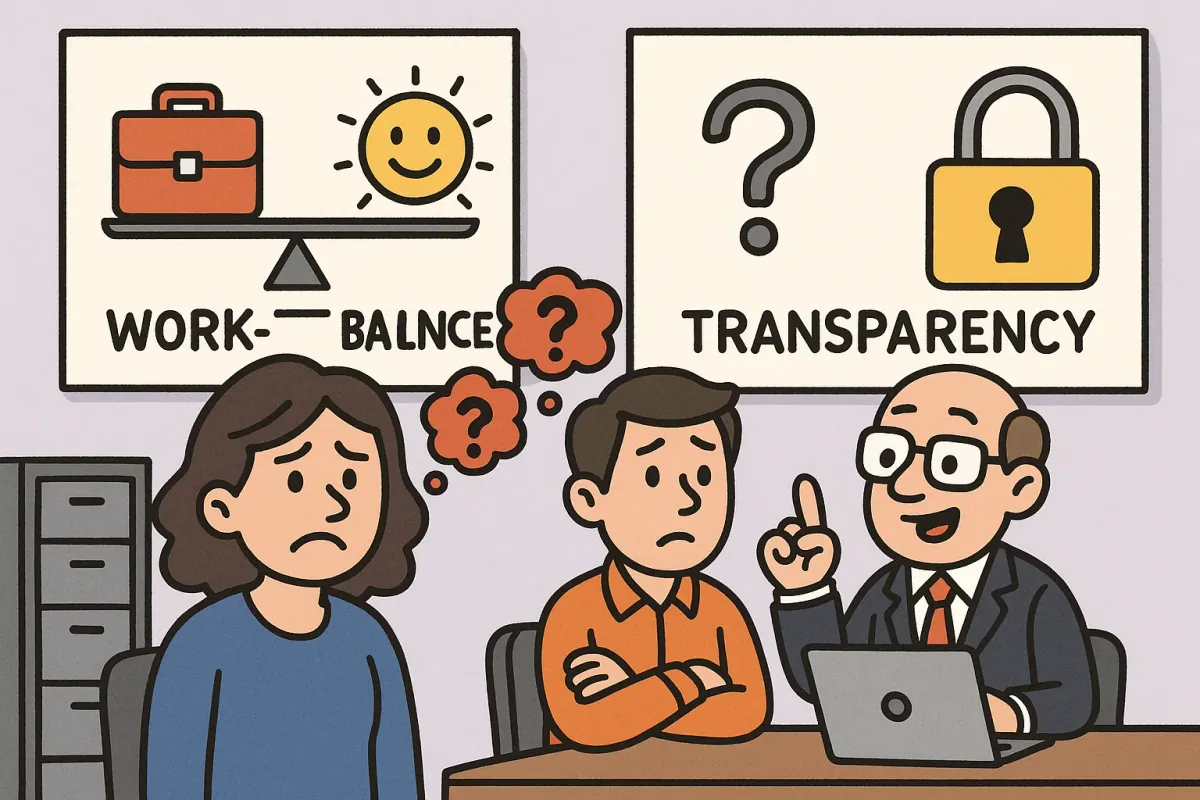The Silent Trust Killer: Is Cognitive Dissonance Poisoning Your Workplace?
Is your workplace saying one thing but doing another? Discover how cognitive dissonance erodes trust, sparks stress, and what leaders can do to build a culture of true alignment and engagement.

Ever been in a meeting where the company’s "core value" of transparency is praised, right before learning that critical information about the company's health was intentionally withheld? Or maybe your company champions "work-life balance" on its careers page, but the only people getting promoted are the ones answering emails at 11 PM.
If these scenarios feel familiar, your organization might be suffering from a case of cognitive dissonance. It’s more than just corporate hypocrisy; it’s a powerful psychological phenomenon that creates stress, erodes trust, and can silently dismantle a company from the inside out.
What Exactly Is Cognitive Dissonance?
First identified by psychologist Leon Festinger, cognitive dissonance is the mental discomfort we feel when we hold two or more conflicting beliefs, or when our actions contradict our values. This internal conflict creates a tension that our brains are hardwired to resolve. We might change our beliefs, change our behavior, or, most commonly, rationalize the contradiction to make the discomfort go away.
In the workplace, cognitive dissonance is rampant and incredibly damaging. It’s the gap between what a company says it is and what it actually does.
Common examples include:
- Values vs. Practices: A company preaches "work-life balance" while rewarding employees who work excessive overtime. This forces employees to choose between their well-being and their career progression.
- Vision vs. Reality: Leadership paints a picture of a revolutionary, world-changing product, but the team knows it's riddled with bugs and failing to meet customer needs.
- Transparency vs. Secrecy: A culture of "radical transparency" is promoted, yet critical information about financial stability or strategic pivots is kept under wraps.
- Innovation vs. Risk Aversion: Leaders say they want "innovation and calculated risks," but the first team that tries something and fails is penalized, teaching everyone that failure is not an option.
This disconnect isn't just confusing; it's a major source of stress, anxiety, and burnout for employees who are forced to navigate these contradictions daily.
How to Spot the Red Flags of Dissonance in Your Culture
Cognitive dissonance isn't always obvious, but it leaves behind clear symptoms. If you see these signs, it’s time to pay attention:
- Inconsistent Messaging and Actions: The most obvious sign is when leaders say one thing but do another. This hypocrisy erodes leadership credibility at its core.
- Widespread Cynicism and Low Morale: Employees express frustration, confusion, or a general sense of dissatisfaction with the company’s direction. There's a feeling that the stated values are just for show.
- High Turnover: A revolving door of employees, especially top performers, is a massive red flag. Talented people are the least likely to tolerate a culture they perceive as hypocritical and will seek opportunities elsewhere.
- A Culture of Blame and Gossip: When dissonance is high, people may resort to unhealthy coping mechanisms like blaming others for their discomfort, spreading rumors, or becoming aggressive. Instead of addressing the root conflict, they externalize it.
- Lack of Open Dialogue: Employees feel they can't voice concerns or point out inconsistencies without fear of being ignored or, worse, punished. This fear silences valuable feedback and allows problems to fester.
- Employee Disengagement: When faced with persistent dissonance, many employees withdraw. They stop offering their best ideas and discretionary effort, shifting into an "employment preservation mode" where their main goal is to avoid trouble rather than contribute to the mission.
How to Fix It: Building a Culture of Alignment
Addressing cognitive dissonance isn't a quick fix, but it's a necessary one for any organization that wants to build a foundation of trust and achieve long-term success. The work starts with leadership.
- Lead by Example and Live Your Values: Culture starts at the top. Leaders must model the behaviors they want to see. If you want a collaborative culture, you must be collaborative. If you value honesty, you must be honest, especially when it's hard. This alignment between words and actions is the most powerful tool for building trust.
- Audit Your Actions vs. Your Values: Regularly and honestly assess whether the company’s practices, policies, and rewards align with its stated values. If you discover a disconnect, take immediate and visible steps to correct it.
- Foster Psychological Safety: Create an environment where people feel safe to speak up, ask questions, challenge ideas, and admit mistakes without fear of humiliation or punishment. When employees feel safe, they are more likely to offer the honest feedback needed to close the gap between vision and reality.
- Be Radically Transparent: Be upfront about challenges, the reasoning behind difficult decisions, and changes in direction. Employees are far more forgiving of tough situations when they understand the "why" behind them. Consider implementing anonymous feedback channels to encourage honest input from those who may still fear speaking up directly.
- Align Your Reward Systems with Your Values: Stop rewarding the behavior you claim to discourage. If you value innovation, celebrate learning from calculated risks, not just successful outcomes. If you value teamwork, reward collaborative success, not just individual heroics.
- Invest in Leadership Training: Equip your managers with the tools and training they need to align their own actions with company values and to foster psychological safety within their teams.
Cognitive dissonance is a silent trust killer, but it doesn't have to define your organization. By consciously and consistently closing the gap between what you say and what you do, you can create a culture where trust flourishes, engagement grows, and people are empowered to do their best work. Because at the end of the day, trust is built one aligned action at a time.



